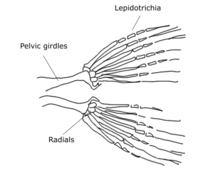Pelvic fin

Pelvic fins or ventral fins are paired
Structure and function
Structure
In
Pelvic fin structures can be extremely specialized in actinopterygians.
-
Pelvic fin skeleton for Danio rerio, zebrafish.
-
Gobiids have modified their pelvic fins into adhesive suckers.
-
Lumpsuckers use their modified pelvic fins to adhere to the substrate.
Function
In actinopterygian steady state swimming, the pelvic fins are actively controlled and used to provide powered corrective forces.[4][5] Careful timing of the pelvic fin movement during whole-body movements allows the pelvic fins to generate forces that dampen the forces from the entire body, therefore stabilizing the fish. For maneuvers, electromyogram data shows that pelvic fin muscles are activated after the start of the maneuver, indicating that the fins are used more for stabilization instead of generating the maneuver.[4]
In rays and skates, pelvic fins can be used for "punting," where they asynchronously or synchronously push off the substrate to propel the animal forwards.[6]
Development
Unlike limb development in tetrapods, where the forelimb and hindlimb buds emerge at roughly the same timepoint, the pelvic fin bud emerges much later than the pectoral fin.[7] While the pectoral fin bud is apparent at 36 hours post fertilization (hpf) in zebrafish, the pelvic fin bud is only clear at around 21 days post fertilization (dpf), roughly when the animal is 8 mm in length.[citation needed]

In zebrafish, the pelvic fin bud starts as a mesenchymal condensation that forms an apical ectodermal thickening.[7] A fin fold forms from this thickening, which is then invaded by migratory mesenchyme, separating the fin bud into the proximal mesenchyme (which will give rise to the endoskeletal girdle and radials) and the distal mesenchyme (which will give rise to dermal fin rays).[7]
References
- ISBN 9780226313405.
- S2CID 85634593.
- ^ Shibukawa, Koichi, Dinh Dac Tran, and Loi Xuan Tran. "Phallostethus cuulong, a new species of priapiumfish (Actinopterygii: Atheriniformes: Phallostethidae) from the Vietnamese Mekong." Zootaxa 3363.1 (2012): 45-51.
- ^ PMID 18775930.
- PMID 20154199.
- S2CID 14758769.
- ^ S2CID 1021058.




